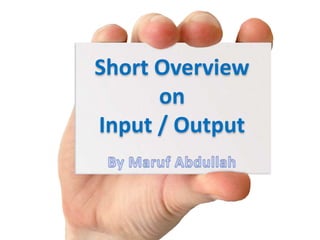
Input Output - Computer Architecture
- 1. Short Overview on Input / Output
- 2. Introduction In this slide I will discuss on Input/Output Procedures & Devices. But before starting any topic, we all need to have clear concept on Computer Architecture that’s why will speech on it first.
- 3. What is Computer Architecture? In computer science, computer architecture is a set of instructions that describe computer organization and implementation of computer systems. So from the definition we can easily understand that Computer Architecture is …………. Set of Instructions Computer Organization Computer Architecture
- 4. Input/output Module External devices are not generally connected directly into the bus structure of the computer. I/O module is an interface for the external devices (peripherals) to CPU and Memory.
- 5. General Structure of I/O Module (Internal) Figure: General model of Internal I/O module
- 6. System Bus A system bus is a single computer bus that connects the major components of a computer system. It combines the functions of a data bus to carry information, an address bus to determine where it should be sent, and a control bus to determine its operation. Peripheral Devices A computer peripheral is a device that is connected to a computer but is not part of the core computer architecture. Peripheral devices can be external or internal. For example: Mouse, Keyboard, Monitor, Printer, Hard-Disk etc..
- 7. External Device Interface It is divided into Control module, Status signal & Data module. Control signal decide which function will execute by device. For example: READ, WRITE operations. Status signals indicates the state (READY, NOT-READY) of the device. Data module controls set of data bits need sending & receiving. Control logic perform device operation control by getting command from I/O. The transducer converts data from electrical to other form of energy during output and from other
- 8. External I/O Module Diagram Figure: External I/O Module Diagram
- 9. Input/output Techniques There are Three principle I/O techniques. They are … o Programmed I/O. o Interrupt Driven I/O. o DMA (Direct Memory Access) technique.
- 10. Programmed I/O CPU controls I/O directly by doing following three things …… Sending Status. I/O commands. Transferring data. CPU waits for I/O module to complete operation. CPU time wastes.
- 11. I/O Commands Control: Control command is used to active a peripheral and tell it what to do. Test: This command is used to test various status conditions associated with an I/O module and its peripherals. Read: It is used to obtain an item of data to peripheral and place it in an internal buffer. Write: to take an item of data (byte or word) from the data bus and subsequently transmit that data item to the peripheral.
- 12. Interrupt Driven I/O • A better protocol is to have the computer and IO device work independently. • I/O module interrupts when ready. • When the current instruction completes, the computer interrupts the current program, saves the current state and goes to an interrupt service routine.
- 13. How Interrupt Driven I/O Works CPU issues read command. I/O module gets data from peripheral whilst CPU does other works. I/O module interrupts CPU. CPU requests for data. I/O module transfers data.
- 14. DMA (Direct Memory Access) Direct memory access (DMA) is a feature of computer systems that allows certain hardware subsystems to access main system (RAM) memory independently of the central processing unit (CPU). Without DMA, when the CPU is using programmed I/O, it is fully busy for Read or Write operation and unavailable to perform other work. With DMA, the CPU first begins the transfer, then it does other operations while the transfer is in progress.
- 15. I/O Problems Slower than CPU & RAM. Need I/O modules. For variety of peripherals it may show different amount of data, speeds & formats. Whole system must have to be efficient to receive input & show output.
